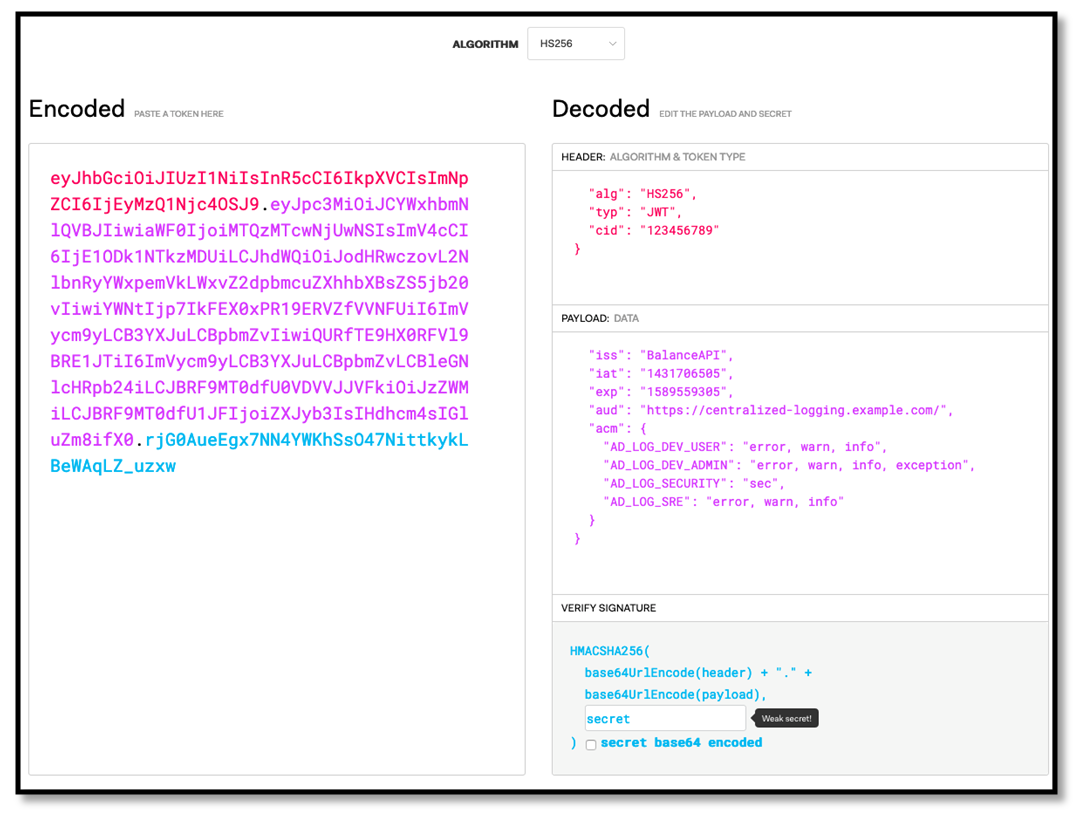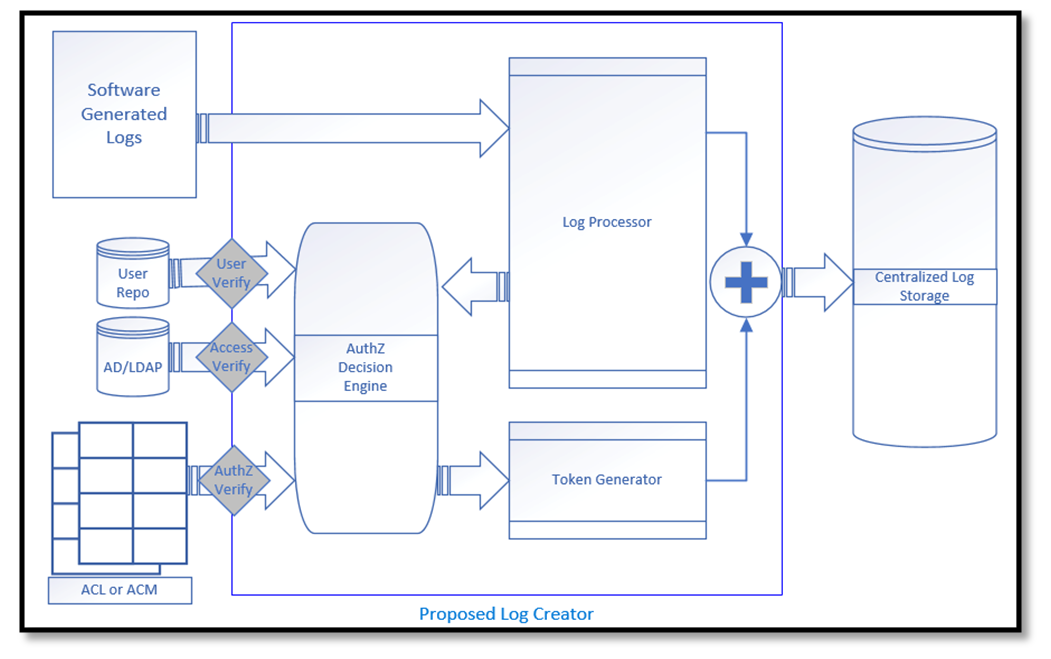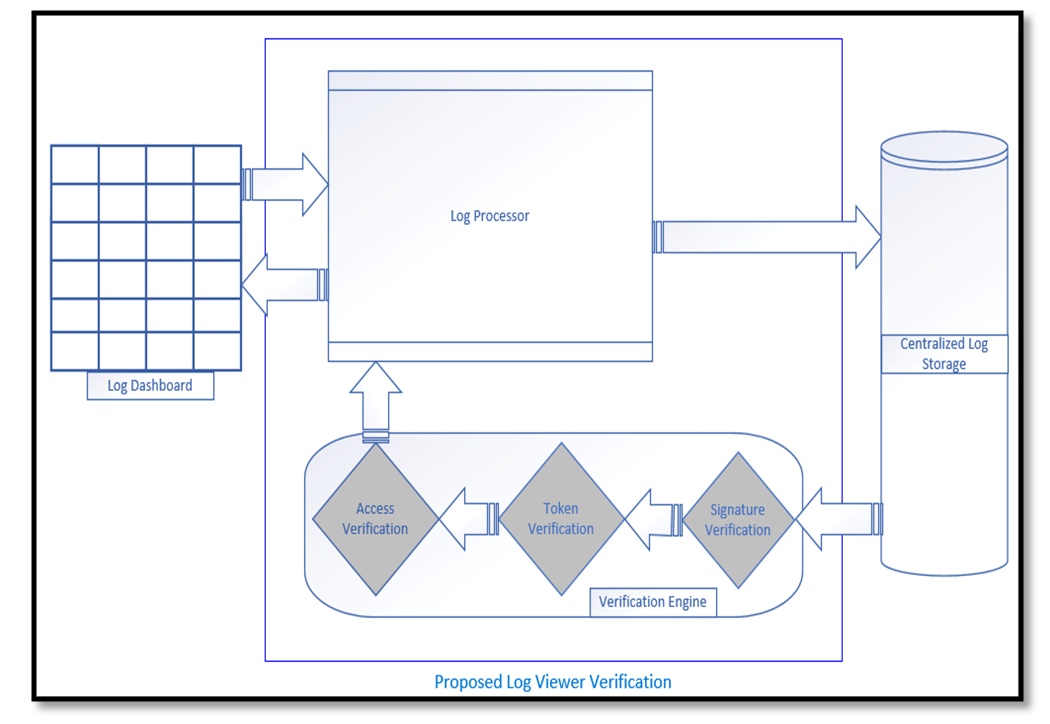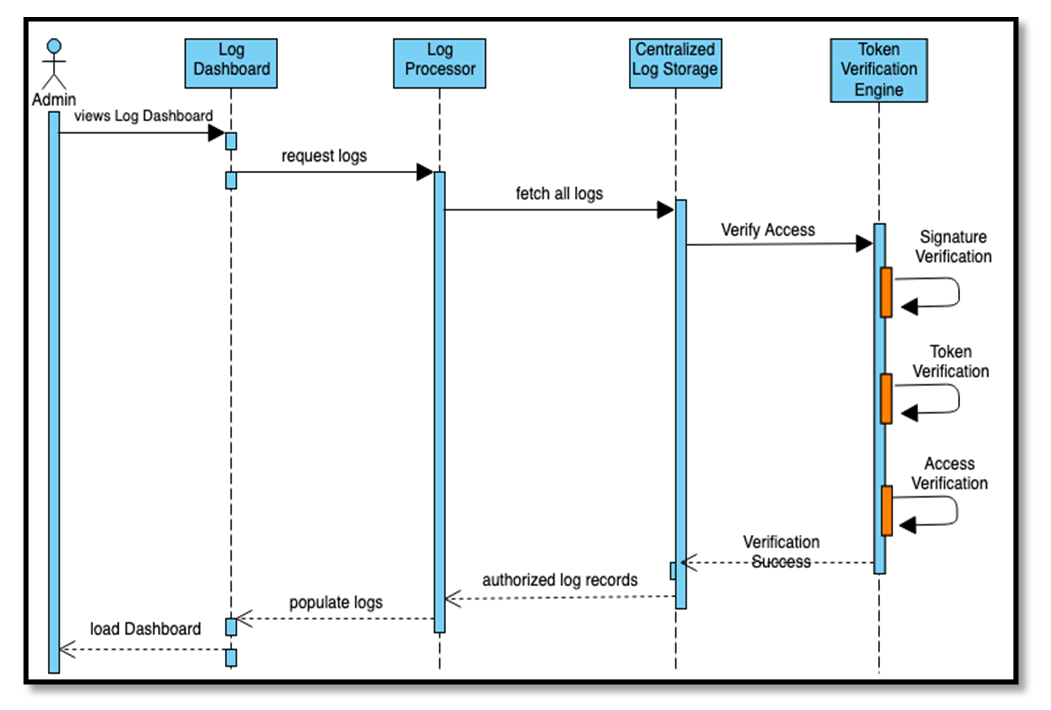-
Paper Information
- Paper Submission
-
Journal Information
- About This Journal
- Editorial Board
- Current Issue
- Archive
- Author Guidelines
- Contact Us
Computer Science and Engineering
p-ISSN: 2163-1484 e-ISSN: 2163-1492
2020; 10(1): 22-30
doi:10.5923/j.computer.20201001.03

Implementing Granular Access Definitions in Log Records
Sandeep Jayashankar, Subin Thayyile Kandy
USA
Correspondence to: Sandeep Jayashankar, USA.
| Email: |  |
Copyright © 2020 The Author(s). Published by Scientific & Academic Publishing.
This work is licensed under the Creative Commons Attribution International License (CC BY).
http://creativecommons.org/licenses/by/4.0/

This document specifies a method of creation or generation of software logs that would further assist in building more granular access control definitions. The technique relies on including an authorization token within each log record, which is generated using a signed JSON Web Token (JWT). Each authorization token embeds all factual information that lets the log viewers set these access constraints, either using an external access control list or applying an access control list outlined in the log management platform.
Keywords: JWT, Authorization, Tokens, Software Logging, Access Definition, Secure Log Records, Secure Logging Mechanism, JSON Web Tokens
Cite this paper: Sandeep Jayashankar, Subin Thayyile Kandy, Implementing Granular Access Definitions in Log Records, Computer Science and Engineering, Vol. 10 No. 1, 2020, pp. 22-30. doi: 10.5923/j.computer.20201001.03.
Article Outline
1. Introduction
- A logging mechanism in any software implementation is the core utility for debugging the behavior, either during a failure or during a successful transaction. As the software runs, the logging mechanisms continuously create a trail of event checkpoints, by capturing ample information about the software’s state. For developers and system administrators who are tasked with debugging a specific software's behavior, these event trails are gold mines of valuable information.Since logs serve as the source in the debugging process, all recorded information about the event should be available in log records at the time of perusal. However, this provision may result in software incidentally logging sensitive information, resulting in exposure of critical data to unauthorized personnel. There are also occasions when developers or system administrators are required to examine detailed log data which may contain sensitive information, however, restrictions could be enforced from accessing those logs. Therefore, an urgent requirement is warranted to implement precise and granular access controls in the log platforms. Even if some of the restrictions are already enforced, there is a need for a solution that can embrace the integrity conditions for the authorization definitions.
2. Current Trends in Logging Mechanisms
- Many software entities in enterprise environments require logging mechanisms to create and store appropriate logs. More importantly, the application and web servers, database servers, API endpoint servers, security solutions like firewalls, all require logging mechanisms to capture the event appropriately. For ease of use, logs from various sources are typically placed into centralized storage repositories for user consumption by users with appropriate access.Implementing "Least Privilege" and "Need-To-Know" security principles may be cumbersome in an environment supporting a large organization. This constraint has led to many organizations redefining their security best practices to refrain from including sensitive or personal identifiable information in the records.Another practice is to limit user access from viewing a set of logs altogether. Examples of restriction-based access controls are listed below:• Based on Log Level (error, warn, info, debug)• Based on specific applications• Based on origination (App, DB, Web, API)• Based on data ownersIn all the above examples, the access control definitions can never achieve the granularity it suitably requires. Additionally, defining access controls for every log record has considerable administrative overhead, and could have storage and data processing implications. Hence, there is a need for a secure and lightweight mechanism that can embed each log record with access information.
3. Token Type and Its Features
- JSON Web Tokens (JWT) is an open standard (RFC 7519) that defines an efficient way of encapsulating a set of data, and securely transmitting them in a JSON format. By design, JWTs are meant to support lightweight transactions, and formulating the whole token in a JSON format helps them achieve the primary goal of being uncomplicated. Considering other tokens such as SAML (Security Assertion Markup Language) tokens, which use XML, JWTs are compact due to the same reason. Moreover, JSON formats have extensive usage in the current technology landscape, and parser support is available in all programming languages. Hence, the lack of required escape or encoding characters keep the token compact and lightweight. The second goal of securely transmitting data is possible by adding a digital signature to the token's contents. The digital signature is a mandatory part of any JWTs and signing token contents warrants the integrity provisions of a secure implementation. Unlike SWT (Simple Web Tokens), which only supports symmetric signing algorithms, JWT supports symmetric and asymmetric digital signatures. Depending upon the degree of integrity requirements, any suitable digital signature algorithm can be selected, thus achieving a proper balance between the lightweight token and the security aspect. Even though JWTs have provisions for encrypting the contents of the token and act as an authentication sequence, the usage of JWTs in the current article is mainly from the authorization perspective. Thus, we discuss more towards the usage of hashing algorithms and signing the contents using private keys.
4. Token Contents
- JWTs, by default, contains mainly three parts, a header, payload, and the signature. The header and payload contents of a JWT token utilize an encoding format, "Base64URL", to ensure the fulfillment of token encapsulation criteria. The contents of a JWT is explained in more detail below:Headers contain two main parts; the signature algorithm and the type of token used for generating the JWT. Concerning the token type used, JWTs always use the value "JSON" for a defined claim "typ" in RFC-1759. The RFC-7519 represents the claim "alg" to identify the digest hash or signature algorithm used during token generation. In addition to the two above claims, "cid" (correlation ID) can also be utilized to correlate a specific event and its pertaining logs from different solutions.
 The token's payload contains all the information required for the authorization sequence to ensure that the log record is only those who have permission to view it. The main contents of the payload, as per the initial design, is the following:The below claims are as per the RFC-7519:1. iss (issuer): The issuer defines the entity that has created the log record. The value can be an application name, infrastructure entity, or even another log server.2. iat (created date and time): The date when the log record originates.3. exp (expiry date and time): The date when the log record expires.4. aud (audience): The audience can specify the centralized log server where logs collaborate. Additionally, to define the Access Control Matrix or Access Control Lists, the below claims are utilized.5. acm (access matrix): This claim helps build a two-dimensional access matrix for each log record, with the precise access and the associated log level.6. acl (access control list): This claim helps build a uni-dimensional access control list for each log record, with just the access defined.The illustration below shows the proposed JWT payload using an Access Control Matrix:
The token's payload contains all the information required for the authorization sequence to ensure that the log record is only those who have permission to view it. The main contents of the payload, as per the initial design, is the following:The below claims are as per the RFC-7519:1. iss (issuer): The issuer defines the entity that has created the log record. The value can be an application name, infrastructure entity, or even another log server.2. iat (created date and time): The date when the log record originates.3. exp (expiry date and time): The date when the log record expires.4. aud (audience): The audience can specify the centralized log server where logs collaborate. Additionally, to define the Access Control Matrix or Access Control Lists, the below claims are utilized.5. acm (access matrix): This claim helps build a two-dimensional access matrix for each log record, with the precise access and the associated log level.6. acl (access control list): This claim helps build a uni-dimensional access control list for each log record, with just the access defined.The illustration below shows the proposed JWT payload using an Access Control Matrix: The final part of a JWT is the hash digest or the digital signature of the header and the payload. The following algorithms are supported:• Symmetric Algorithms: JWTs use the HMAC algorithm with SHA cryptographic message digest. Depending upon the size of the SHA digest required, JWTs support 256, 384, and 512 sized HMAC algorithms.• Asymmetric Algorithms: JWTs use RSASSa-PKCSv1.5 (RS), ECDSA (ES), and RSASSA-PSS (PS) algorithms with SHA cryptographic digests (256, 384 and 512), and a private key to sign the contents.By using the header and the payload from the examples above, a JWT with HS256 algorithm is shown below (secret phrase being “secret”):
The final part of a JWT is the hash digest or the digital signature of the header and the payload. The following algorithms are supported:• Symmetric Algorithms: JWTs use the HMAC algorithm with SHA cryptographic message digest. Depending upon the size of the SHA digest required, JWTs support 256, 384, and 512 sized HMAC algorithms.• Asymmetric Algorithms: JWTs use RSASSa-PKCSv1.5 (RS), ECDSA (ES), and RSASSA-PSS (PS) algorithms with SHA cryptographic digests (256, 384 and 512), and a private key to sign the contents.By using the header and the payload from the examples above, a JWT with HS256 algorithm is shown below (secret phrase being “secret”):
 | Figure 1. Screenshot from https://jwt.io showing the token generated with example values |
5. Proposed Logging Mechanism
- The proposed logging mechanism is a full-stack logging platform, which includes the Log Generation Process and a Log Viewer Verification process. Each illustrated process in the proposed logging mechanism contains multiple sub-components that can act as a separate software entity. The modularized design takes into consideration the software development challenges, and decoupling software modules help development efforts to be more manageable. Log Creation ProcessThe Log Generation process acts as a middle layer between the software-generated logs and the centralized logging platform. In this pivotal position, the log creation process consolidates the retrieved log record and assigns the correct access definitions. Following are the sub-components as per the propose designed:• Log Processor: In the proposed solution, the log processor is the single point of entry service that accepts all software generated logs for processing. The processing includes two aspects; correlating logs based on a specific event and collecting the information the ADE (AuthZ Decision Engine) requires. The Log Processor sends the original log record to the next step, where the logs concatenate with the generated authorization token to form the final log record.• Authorization Decision Engine (ADE): The Authorization Decision Engine ensures that for every log record from the Log Processor, the right set of access definitions are formulated and provided to the Token Generator. Depending upon the environment in the network, the ADE can collect the access control and user information from Active Directory, a user-object repository, or from a mechanism that has an access control matrix/list compiled. • Token Generator: Based on the Token Contents described in the previous section, the Token Generator requires the following from different sources: ο The Log Processor provides the required information for the formation of the claims, cid, iss, iat, exp, and aud. ο The ADS provide the claims, acm, or acl to the Token Generator. ο The claims, typ, and alg has to be set as an environmental variable or can be a constant value for implementation. Once the respective sources transmit the required information, the Token Generator utilizes a pre-existing library from many supported development languages to compile the complete token. This generated token acts as the authorization token for that specific log record. Finally, the log record includes a column for the the authorization token which gets stored in the centralized log storage.
 | Figure 2. Process diagram showing the proposed Log Creator mechanism |
 | Figure 3. Sequence diagram showing the proposed Log Generator flow |
 | Figure 4. Process diagram showing the proposed Log Viewer Verification mechanism |
 | Figure 5. Sequence diagram showing the proposed Log Viewer Verification flow |
6. Implementation Requirements
- The Implementation requirements mainly attempt to propose the general provisions of the algorithms and not to set a mandatory requirement to implement the proposed mechanisms effectively. It is up to the implementation software to dictate what algorithms are advisable to use for each implementation design. However, proper care is recommended during the algorithm selection by embracing the understanding that any flexibility in the security requirements for convenience or performance may result in the implementation to be ineffective. The following are the security best practices, or recommendations, concerning the algorithm selection and the key sizes. The security level required for the software implementations can be finetuned by changing the SHA key size to each algorithm. The below description shows how each algorithm can provide benefits over the others:• Software solutions can utilize RSAPSSSHA384 (RSA Signature with the probabilistic signature scheme with SHA-384) to implement a JWT signature mechanism with the highest security setting. The probabilistic signature scheme is proven not to be susceptible to the same type of attacks that affect the PKCS and other RSA implementation flavors. The "alg" claim values for DSA with EC are PS256, PS384, or PS512, depending upon the SHA's digest size. • The ECDSASHA512 algorithm (Elliptic Curve Digital Signature Algorithm with SHA-512) is a close second option for software solutions that require a very high degree of security setting. The DSA algorithm is proven to be faster at signing digital signatures compared to RSA. However, RSA is proven to be faster at verifying digital signatures. Hence, depending upon the implementation requirements, the software solutions can choose either ECDSA or RSA-PSS. The "alg" claim values for DSA with EC are ES256, ES384, or ES512, depending upon the SHA's digest size. • The RSASHA512 algorithm (RSA signature with PKCS#1 v1.5 with SHA-512) is a standard option for software solutions that require interactions with other third-party systems. The PSS flavor of RSA is not as prevalent as PKCS#1 v1.5, but since the algorithm is deterministic, it is prone to many practical attacks. Also, RSA PSS is a complex algorithm to implement, and it takes a considerable amount of time to compute. Hence, using the RSASHA512 algorithm may reduce the security posture of the implementation, but it is beneficial from a performance and support aspect. The "alg" claim values for RSA with PKCS#1 v1.5 are RS256, RS384, or RS512, depending upon the SHA's digest size. • The HMACSHA512 (HMAC with SHA-512) uses a symmetric algorithm with a secret key shared between two parties. Since there are no public-private key pairs, but just a secret key, there is a considerable gap in the security posture if the secret key is compromised. However, the HMAC algorithm is known to be fast and simplistic and very advantageous in the performance aspect. The "alg" claim values for the HMAC algorithm are HS256, HS384, or HS512, depending upon the SHA's digest size.The below implementation requirements are for the proposed process: • Log Processor: As per the proposal, the Log Processors are envisioned as an API endpoint that allows software entities to call when an event trigger. The implementation can act as a separate entity to the main software solution, such as a provisioned software-as-a-service or can be part of the software solution. However, proper measures must be taken to ensure that the API endpoints are authenticated adequately and have appropriate network zoning restrictions so that it is not exposed to the external environment.• AuthZ Decision Engine (ADE): The ADE is an integral part of the proposed implementation, as it assumes the responsibility of proper access definitions to each log record. Hence, it is recommended to implement secure channels for its interactions with Active Directory, ACM/ACL providers, and the User databases.• Token Generator: While generating the tokens, proper measures must be taken to ensure that the token claim, "alg" is assigned with the correct cryptographic algorithm. Since the token generation process mainly utilizes an open-source library or a separate software entity/framework, it is recommended that care be taken to ensure there are no pre-existing vulnerabilities in the token generation mechanism. • Verification Engine: The software solution utilized for this measure should verify that the authorization tokens conform to the JWT's RPC structure, with appropriate JSON object schema. Additionally, the Base64URLDecode of the authorization token should result in a fully formed header, payload, and signature digest. Furthermore, it is advisable to have the header and payload go through a canonicalization sequence. This progression ensures that the header and payload are verified after eliminating any encoding formats, thus enforcing uniformity in the data before verification. Finally, before authorizing the token, the Verification Engine should validate the RPC specified claims such as exp (token expiration) and iss (issuer/issuing authority).
7. Interoperability Considerations
- To achieve an acceptable and interoperable deployment of the proposed mechanism, the sub-components and their underlying system entities should be in sync with each other. Any changes in the configurations without updating the others may result in breaking the entire proposed mechanism.The following are some of the configurations that are critical from an interoperability perspective: • "iss" and "aud" claim in the payload: The Issuer identifies where the log record originated. This information is essential for the ADE to assign the appropriate access definition to the suitable end-users, and for the verification engine to provide access to authorized end users. Hence, it is vital to set prerequisite configurations that identify issuers and audience values accurately. • Storing sensitive information securely: The software-sensitive information in this proposed solution is the private keys used for generating the JWT signature. The Token Generator requires access to these private or secret keys and storing them in plaintext may pose a security risk. Hence, proper measures to store these private or secret keys in an encrypted format is recommended.• Network Zoning in an enterprise environment: The Network environment must be zoned based on the defined trust boundaries and the sub-components' sensitivity. In this proposed solution, the Log Processor API must be network accessible only to the software that generates logs. The other sub-components, such as ADE and Verification Engine, can be designated to be at the Operations Zone. Since the Token Generator is an integral part of the implementation, and since it handles the private keys for generating a signature, it can be designated to the restricted zone.• Server Authentication between sub-components: Each sub-component defined in this logging mechanism are designed to be decoupled with each other. Implementing an effective server authentication and a secure transmission channel (preferably mutual TLS) is essential as attackers can target sub-components and formulate a successful man-in-the-middle attack.• Supporting Centralized Log Storage: The proposed implementation acts as an intermediate framework between the software generating logs, the centralized log storage, and the Log Dashboard. Hence, there is a need for currently available centralized log storage solutions and Log Dashboard to support the feature, either by providing a calling API service or invoking proposed API implementations.
8. Security Considerations
- The proposed mechanism extensively utilizes the JSON Web Tokens as an authorization token. While JWTs are secure by design, many attacks, vulnerabilities, and security gaps have been identified in the implementation and configurations. Some of the reported public vulnerabilities can be mitigated by following the recommendations below:• Algorithm Verification Bypass: The "None" Algorithm vulnerability resulted due to applications not verifying if signature algorithms are specified in the token headers. As a result, attackers crafted malicious JWTs by assigning the "alg" claim to "none", which resulted in JWTs getting verified even without signature hashes assigned to them. Hence, the Token Generator should explicitly specify which algorithm is utilized, and the Verification Engine must confirm that the "alg" claim is assigned with strictly approved values.• HMAC "Verify" Attack: The signature verification part of many JWT Libraries was found not to accept the verification algorithm as a function parameter. As a result, attackers could use the public key to formulate a signature and replace the algorithm to be HS256. Currently, JWT libraries mandate algorithm values to be sent as a parameter in the “verify” function. In accordance, the Verification Engine in the proposed mechanism should also mandate the algorithm claim ("alg") in the token, and also accept the algorithm parameter for all supported verification functions/ methods.• Sensitive Data in Tokens: The proposed mechanism generates JWTs that are not intended to handle confidentiality, but instead support the integrity of the token contents. Hence, it is not advisable to contain any application or user sensitive data as part of the token. If any instance of instantaneous information leakage occurs, proper care must be exercised to delete the token and generate a new token.• Using a robust symmetric key: HMAC signature digests are prone to brute-force or dictionary attacks if the keys are not robust enough. There are currently many JWT attacking tools such as JohnTheRipper and JWTBrute, which conduct dictionary attacks to extract the key from the HMAC signature. Hence, it is prudent to utilize robust keys that are generated by securely initialized/seeded pseudo-random number generators (PRNGs).• Use the latest TLS versions: The proposed sub-components should extensively utilize TLS protocols to establish any secure transmission.
Terminology
- For ease of understanding, this paper defines the following key terminology as:• End-User: Unless specified to be the user of a log generating application, the end-user in this proposal refers to those who view the Log Records. • Log Records or Logs: Log Records or Logs are a snippet of information recorded during events while running software, or while a specific entity is performing any actions to achieve a goal.• Log Dashboard: A dashboard with a table of all the log records that is viewable to a user.• User Repo: A repository or a database containing users' identifiable information. • Active Directory: More precisely, Active Directory Domain Service (AD DS) is Microsoft's domain and user service platform providing user account information and their applicable access/authorizations in a Windows environment.• ACM: Access Control Matrix is a matrix of roles vs. which log type can the user access. The ACLs are generally used to check if a specific user has access to viewing a particular log record.• ACL: Access Control List is a complete list of all the roles for whom the log record is accessible.
 Abstract
Abstract Reference
Reference Full-Text PDF
Full-Text PDF Full-text HTML
Full-text HTML